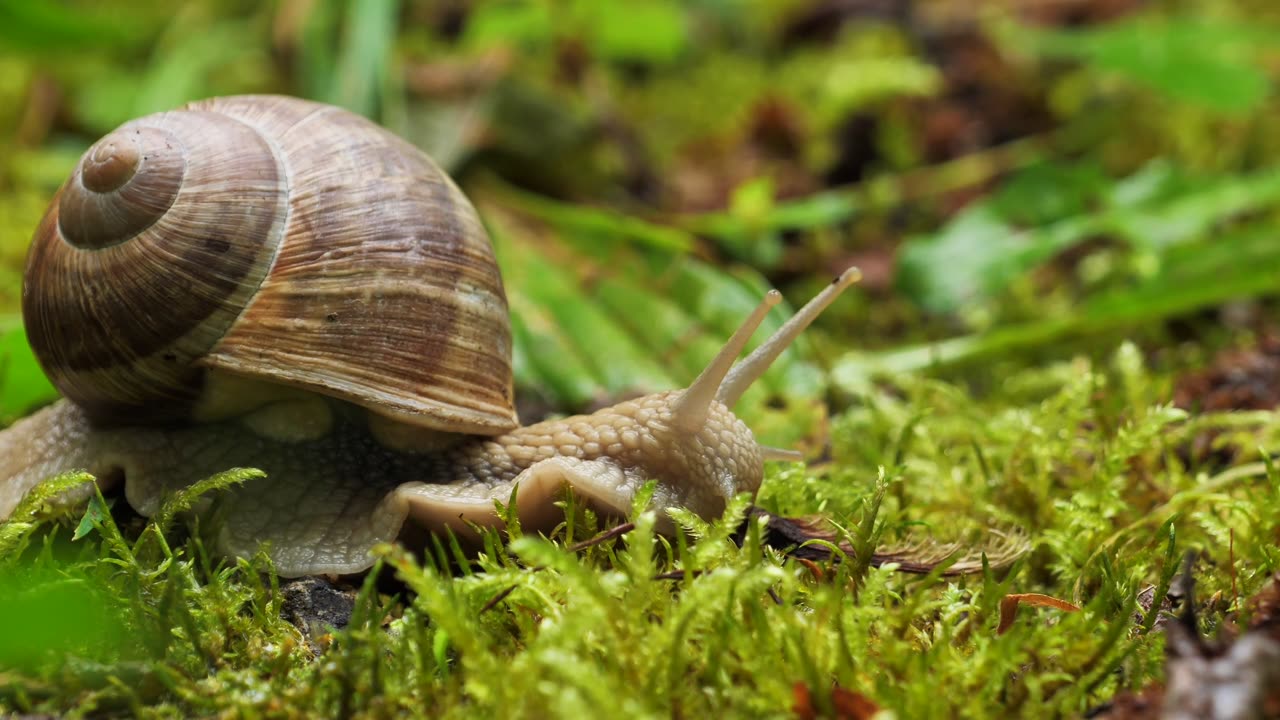Premium Only Content

Snail Mollusk Creeping
Enter the captivating realm of snails, where the enchanting world of mollusks unfolds in a mesmerizing display of slow and graceful movement. Snails, belonging to the class Gastropods, are intriguing creatures that have adapted to a wide array of environments, from lush rainforests to arid deserts. This description delves into the art of snail locomotion, exploring the unique mechanics behind their creeping journey.
At first glance, a snail's locomotion might seem unassuming, yet its elegance lies in its unhurried pace and deliberate method. The process involves a combination of muscular contractions, mucus secretion, and rhythmic undulations. A muscular foot, characteristic of mollusks, becomes the focal point of this locomotion. By rhythmically contracting and relaxing their foot muscles, snails create a rippling motion that propels them forward.
One of the most captivating aspects of snail movement is the mucus trail they leave behind. This silvery secretion serves multiple purposes: it reduces friction against surfaces, aids in gripping various terrains, and even provides a form of moisture retention, essential for snails in drier habitats. As the snail advances, its mucus-enveloped foot glides along, leaving behind a glistening path that tells the tale of its journey.
The diverse habitats snails inhabit have led to fascinating adaptations in their creeping techniques. Forest-dwelling snails, for instance, maneuver deftly over uneven terrain, utilizing their flexible foot to navigate obstacles with surprising agility. Desert-dwelling species, on the other hand, have developed an artful way of sealing themselves within their shells during the day to conserve moisture, emerging only during cooler hours to venture forth in search of nourishment.
Observing the snail's methodical crawl, one cannot help but marvel at its resilience and determination. Despite its leisurely pace, the snail is not without its predators and challenges. Its shell, often ornately adorned, serves as both a protective armor and a symbol of its unique identity. The world of snails is rich with biodiversity, showcasing an astonishing array of colors, patterns, and sizes that have evolved to blend with their surroundings.
In conclusion, the snail's creeping journey unveils a world of intricate adaptation and deliberate movement. Through its rhythmic undulations, mucus-aided glide, and diverse
-
 3:02:10
3:02:10
daniellesmithab
10 hours agoAlberta Next: Fort McMurray Town Hall
9.59K1 -
 2:11:17
2:11:17
Side Scrollers Podcast
19 hours agoINSANE Illegal Migrant Propaganda Xbox Game + Paypal REFUSES To Pay Dev + More | Side Scrollers
56.8K3 -
 20:58
20:58
GritsGG
1 day agoProtect the President Challenge on Warzone!
12.9K -
 1:49:07
1:49:07
The Michelle Moore Show
2 days ago'Biden's Immigration Mess, President's Trump Spiritual Cry For Help, English Speaking Truckers Only, Woke CEO's Killing of Conservative Brands, Palantir's Kill Chain' Mark Taylor: The Michelle Moore Show (Aug 25, 2025)
34K92 -
 LIVE
LIVE
Lofi Girl
2 years agoSynthwave Radio 🌌 - beats to chill/game to
217 watching -
 2:14:18
2:14:18
The Pascal Show
14 hours ago $0.64 earnedTHEY LIED TO POLICE AGAIN? Jake & Rebecca Haro Have Lost Their Minds! Emmanuel Haro Search Continues
8.48K -
 1:25:52
1:25:52
TruthStream with Joe and Scott
2 days agoSG Sits Down w/ LT From "And We Know": An 80K FT View of Humanity's Great Awakening from 8/22/2025
20.9K16 -
 15:54
15:54
Lacey Mae ASMR
12 hours ago $0.88 earnedASMR For Sleep in 15 Minutes!
13.1K10 -
 3:16:38
3:16:38
Price of Reason
13 hours agoTrump FIRES Fed Governor Lisa Cook! Cracker Barrel CRISIS Continues! James Gunn DCU Woes! Gamescon!
116K8 -
 2:25:01
2:25:01
FreshandFit
7 hours agoTyreek Hill Pays Ex Wife $1 Million in Ongoing Fees From Divorce?!
37.5K4